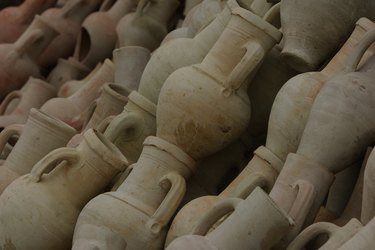
Porcelain is one of the finest clays you can work with — it dries to a smooth, white finish that is slightly translucent. Porcelain has been around since A.D. 700 in China and has become one of the most luxurious mediums with which to work. When sculpting with porcelain clay, remember that it is much harder to work with than other clays — porcelain clay should be used if you have already mastered the art of working with other forms of clay.
Step 1
Knead cold porcelain as you work to prevent any cracks or lines from appearing in the finished piece. If you're using cold porcelain clay, kneading is a very important part of the pottery process because it helps your finished piece turn out smooth. Also, kneading cold porcelain clay is necessary if you plan to add colorants to the clay.
Video of the Day
Step 2
Make your designs 20 to 25 percent larger than you would like them to be to accommodate for shrinking. When you fire porcelain, it will shrink by at least 20 percent so it is always good to consider shrinkage in your design plans, especially if you want to make an object a certain size.
Step 3
Work in a humid environment to prevent the clay from drying out as you work. Porcelain clay has a tendency to dry as you work if the room is too dry. If you find this happening, add a bit of water to your fingertips to help moisten the clay.
Step 4
Work swiftly and firmly when working with porcelain clay. Not only does this clay dry out quickly, but it also has a "memory." This means that if you bend the clay a certain way, it will remember this and bend back to this position when it is being fired.
Step 5
Fire the porcelain in a very high temperature kiln to help it dry properly. Since porcelain shrinks and melts slightly when it is being fired, greenware should be propped up and supported to prevent it from breaking or bending out of shape.
Video of the Day